New 1981-2010 Averages being used this year.
Note: This publication is currently undergoing major revisions. The current publication will be replaced with a new publication based on stakeholder requirements and scientific advances. We expect to begin sharing details on this soon. If you have input on content, format, or publication frequency at any time, please contact us at cbrfc.webmasters@noaa.gov.Great Basin Water Supply Outlook, April 1, 2012Great Basin Water Supply Outlook, April 1, 2012
Contents
Great Basin Summary
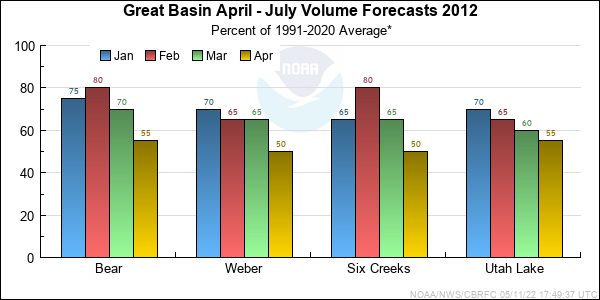
*Median of forecasts within each basin.
Bear Basin Conditions
The following conditions influenced this month's forecasts:
Precipitation:
Seasonal October through March
precipitation was 87 percent of average
in the upper Bear Basin.
March
precipitation was 55 percent of average.
Streamflow:
The Bear River at Stewart Dam was 121 percent of average. The Logan River above State Dam was estimated at 129 percent of average streamflow.
Snowpack:
This years snow pack is much below average for April 1st. The current snow water equivalent for the Bear Basin is 59 percent of average.
As of water year 2012 the CBRFC has re-calculated all snow stations to reflect the new 30 year average from 1981-2010.
Upper Bear River Basin
Snow Plot.
Bear River Below Woodruff Narrows Reservoir
Snow Plot.
Bear River Basin
Snow Plot.
Soil Moisture:
Modeled Soil
Moisture, click on map to zoom. Modeled soil moisture states indicate above average moisture conditions as of March 1st. This is a contributor to
the above average baseflows in the Bear River Basin.
Climate Forecasts:
Climate forecasts were not a factored into the northern Utah forecasts because there is not a strong correlation between
La Nina conditions and winter precipitation.
Forecast Summary:
A wet October was then followed by dry November and December. January and February precipitation was near normal and then the things changed with a
very dry and warm March. Seasonal precipitation throughout the GSL Basin as of April 1st ranges between 73 and 97 percent of average but snowpacks have suffered greatly in March
and range from 49 to 57 percent of average. Streamflow forecast have been significantly reduced from March 1st numbers due to the amount of snow that
melted.
April through July seasonal volume forecast range from 38 to 67 percent of average with a median volume of 55 percent of average.

* Percent usable capacity, not percent average contents.
Click for multi-month Graph.
Weber Basin Conditions
The following conditions influenced this month's forecasts:
Precipitation:
Seasonal October through March
precipitation is 73 percent of
average.
March
precipitation was 58 percent of average.
Streamflow:
The Weber at Oakley gage was estimated to be 112 percent of average. The inflow to Rockport Reservoir was 97 percent of average.
Snowpack:
This years snow remains below average. The current snow water equivalent index is 52 percent of average..
As of water year 2012 the CBRFC has re-calculated all snow stations to reflect the new 30 year average from 1981-2010.
Weber River Basin
Snow Plot.
Upper Weber River Basin
Snow Plot.
Soil Moisture:
Modeled Soil
Moisture, click on map to zoom. Modeled soil moisture states indicate above average moisture conditions as of December 1st. This is a contributor to
the above average baseflows in the Weber River Basin.
Climate Forecasts:
Climate forecasts were not a factored into the northern Utah forecasts because there is not a strong correlation between
La Nina conditions and winter precipitation.
Forecast Summary:
A wet October was then followed by dry November and December. January and February precipitation was near normal and then the things changed with a
very dry and warm March. Seasonal precipitation throughout the GSL Basin as of April 1st ranges between 73 and 97 percent of average but snowpacks have suffered greatly in March
and range from 49 to 57 percent of average. Streamflow forecast have been significantly reduced from March 1st numbers due to the amount of snow that melted.
April through July seasonal volume forecasts range
between 42 and 55 percent of average with a median forecast volume of 48 percent of average.

* Percent usable capacity, not percent average contents.
Click for multi-month Graph.
Six Creeks Basin Conditions
The following conditions influenced this month's forecasts:
Precipitation:
Seasonal October through March
precipitation was near 74 percent of average.
March
precipitation was 67 percent of average.
Streamflow:
March streamflow for City Creek near Salt Lake City was 66 percent of average. Big Cottonwood Creek nr Salt Lake City was 91 percent of average.
Snowpack:
This year's snow remains below average. The current indexed snow water equivalent is 59 percent of average. As of water year 2012 the CBRFC has re-calculated all
snow stations to reflect the new 30 year average from 1981-2010.
Six Creeks Headwaters Basins
Snow Plot.
Big and Little Cottonwood Canyons
Snow Plot.
Soil Moisture:
Modeled Soil
Moisture, click on map to zoom. Modeled soil moisture states indicate mostly above average mositure conditions as of December 1st. Although flows are dropping in the Six Creeks basin, above
average soil moistures have been influencing baseflows through the fall and March was the first month that they dropped to near average.
Climate Forecasts:
Climate forecasts were not factored into the northern Utah forecasts because there is not a strong correlation between
La Nina conditions and winter precipitation.
Forecast Summary:
A wet October was then followed by dry November and December. January and February precipitation was near normal and then the things changed with a
very dry and warm March. Seasonal precipitation throughout the GSL Basin as of April 1st ranges between 73 and 97 percent of average but snowpacks have suffered greatly in March
and range from 49 to 57 percent of average. Streamflow forecast have been significantly reduced from March 1st numbers due to the amount of snow that
melted.
April through July seasonal
volume forecasts range between 42 to 66 percent of average with a median forecast of 48 percent of average.

* Percent usable capacity, not percent average contents.
Click for multi-month Graph.
Utah Lake Basin Conditions
The following conditions influenced this month's forecasts:
Precipitation:
Seasonal October thought March
seasonal precipitation was 76 percent of average.
March
precipitation was 66 percent of average.
Streamflow:
Streamflows for the Provo at Woodland were 99 percent of average. Unregulated inflow to Utah Lake was recorded at 76 percent of average which
represents a significant drop from the previous month.
Snowpack:
This year's snow as of March 1 remains below average. Current snow water equivalent are 67 percent of average.. As of water year 2012 the CBRFC has re-calculated all snow stations to reflect the new
30 year average from 1981-2010.
Provo River, Utah Lake Drainage
Snow Plot.
Soil Moisture:
Modeled Soil
Moisture, click on map to zoom. Modeled soil moisture states indicate mostly average to above average conditions as of December 1st. This is a contributor to
the current baseflows conditions in the Provo and Utah Lake forecast.
Climate Forecasts:
Climate forecasts were not factored into the northern Utah forecasts because there is not a strong correlation between
La Nina conditions and winter precipitation here.
Forecast Summary:
A wet October was then followed by dry November and December. January and February precipitation was near normal and then the things changed with a
very dry and warm March. Seasonal precipitation throughout the GSL Basin as of April 1st ranges between 73 and 97 percent of average but snowpacks have suffered greatly in March
and range from 49 to 57 percent of average. Streamflow forecast have been significantly reduced from March 1st numbers due to the amount of snow that melted.
April through July seasonal volume forecasts range between
26 and 60 percent of average with a median forecast volume of 53 percent of average.

* Percent usable capacity, not percent average contents.
Click for multi-month Graph.
Differences between the full period forecasts and the residual forecasts may not exactly equal the actual observed volumes due to rounding conventions (see Definitions section).
Monthly Streamflows
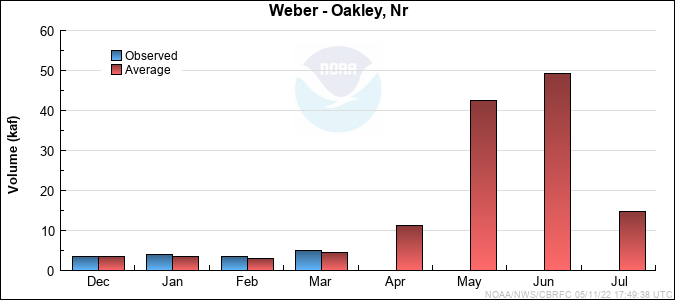
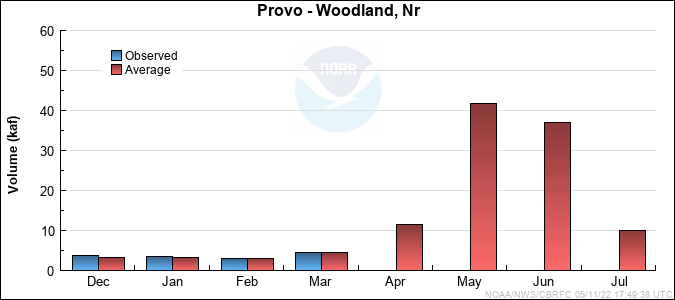
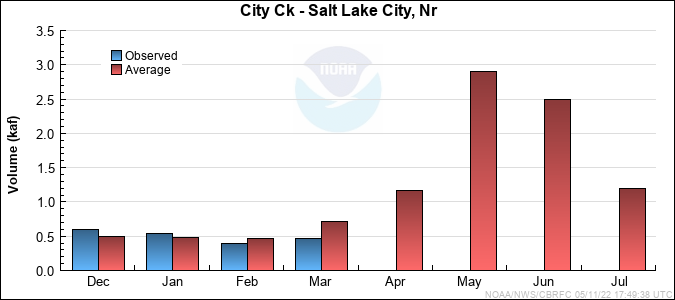
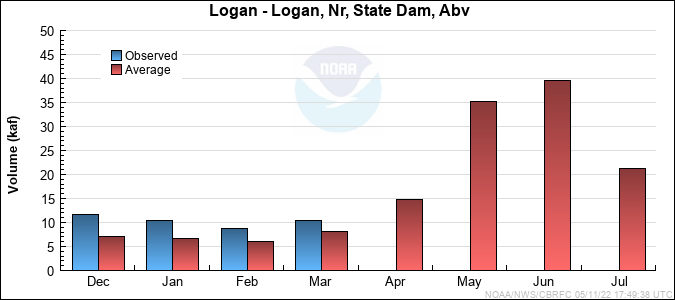
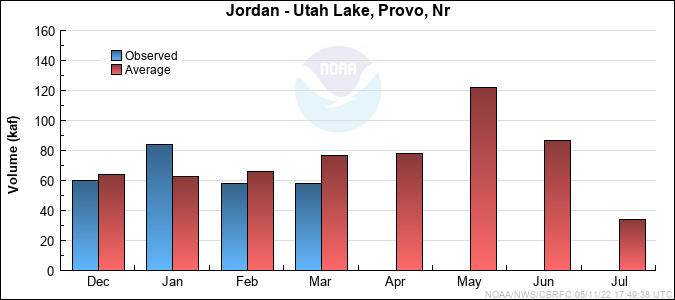
Precipitation Maps
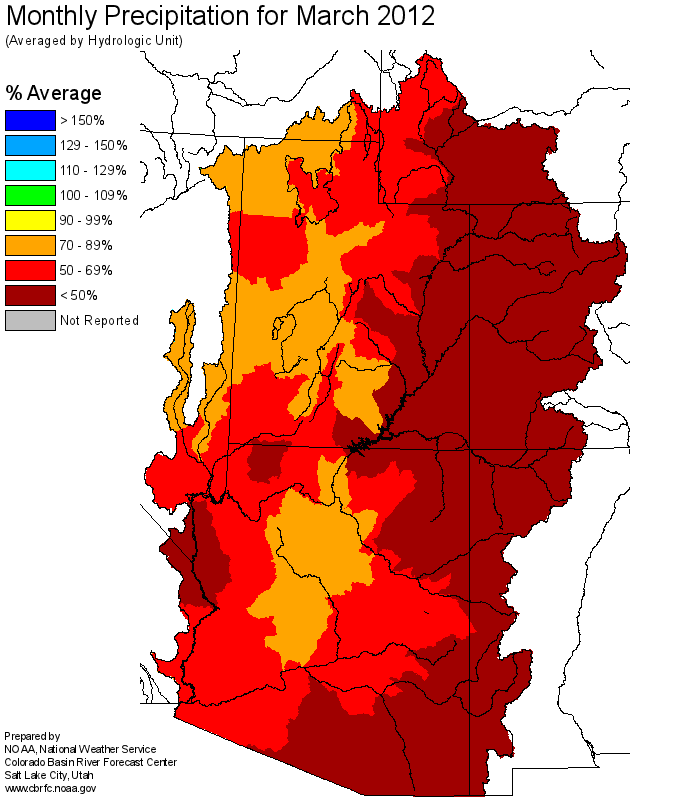
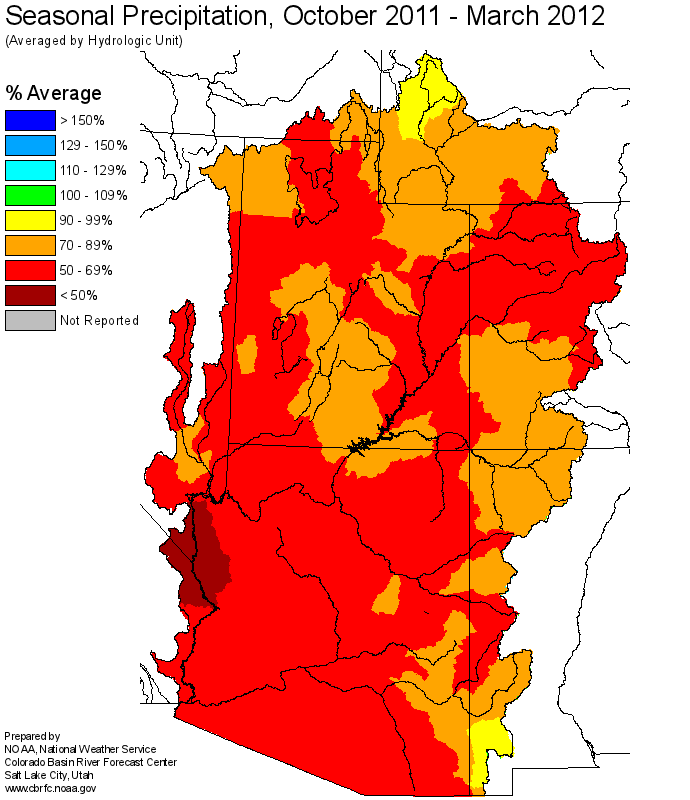
Hydrologist: B.Bernard













